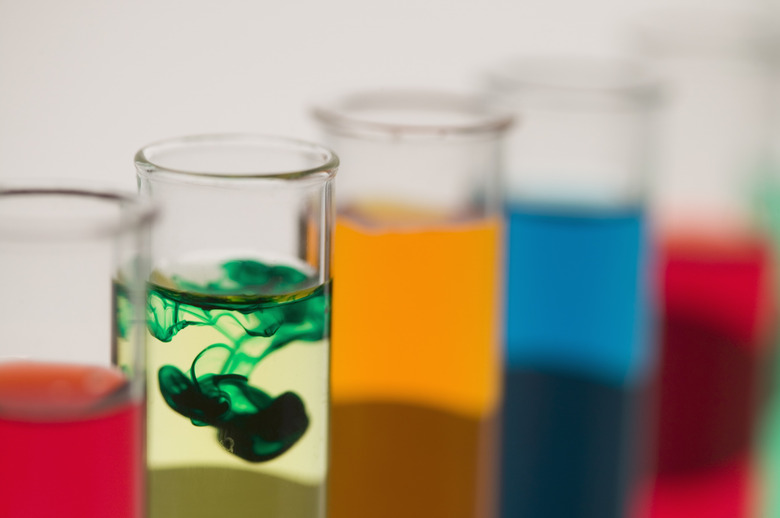Chemistry Projects For Diffusion In Liquids
Diffusion is the random movement of particles, atoms or molecules from areas of higher concentration to areas of lower concentration. This process takes place in all states of matter, whether solid, gas or liquid. Several visual experiments can show you how liquids diffuse through other liquids and how liquids diffuse through membranes.
Food Coloring in Water
Food Coloring in Water
Food coloring added to a glass or jar of water will diffuse through water until all of the water is colored. Pour water into a jar and let it sit until all movement of the water has stopped. Add the food coloring one drop at a time so you can see the drop of color slowly spread out throughout the water. Do the same experiment with one jar of hot water and one jar of cold water to see the effect of temperature on diffusion. If the water is still moving, another form of mixing called convection will carry the food coloring around the jar much faster than diffusion.
Food Coloring in a Gel
Food Coloring in a Gel
Gelatin gels are suspensions that will stay firm so that convection cannot occur, but their composition is mostly liquid water. Prepare two bowls of clear or light-colored gelatin mix, according to the directions, and let them harden in the refrigerator. Once the gelatin is firm, allow one bowl of gelatin to come to room temperature and keep the other cold. Place drops of food coloring at different locations on the surface of the gelatin in both bowls. Cover both bowls and leave them undisturbed for as long as three days, keeping one at room temperature and one cold. Observe the diffusion of color into the gelatin.
Diffusion through a Membrane
Diffusion through a Membrane
Use paper towels as a permeable membrane to demonstrate that small molecules can diffuse across a barrier from one liquid to another. Fill a jar with water and cover the opening with a paper towel in such a way that the center of the paper towel hangs down into the water. Put food coloring into the water that fills the paper towel and observe as the color diffuses through the barrier. Perform the experiment at varying temperatures to show how temperature affects diffusion.
Osmosis Through a Membrane
Osmosis Through a Membrane
Food coloring that diffuses through a paper towel demonstrates the diffusion of small molecules through a barrier, but liquid itself can also diffuse through a barrier. Osmosis is when a liquid containing just a few small molecules diffuses across a barrier to dilute a solution with a high concentration of small molecules. Demonstrate this with eggs. Soak raw eggs for two days in vinegar, which will dissolve the shell and leave a membrane. Measure the size of the egg. Soak the egg again in pure water overnight. The pure water will diffuse across the barrier membrane, diluting the salty water inside the egg and increasing the size of the egg.
Cite This Article
MLA
Bush, Joshua. "Chemistry Projects For Diffusion In Liquids" sciencing.com, https://www.sciencing.com/chemistry-projects-diffusion-liquids-19462/. 24 April 2017.
APA
Bush, Joshua. (2017, April 24). Chemistry Projects For Diffusion In Liquids. sciencing.com. Retrieved from https://www.sciencing.com/chemistry-projects-diffusion-liquids-19462/
Chicago
Bush, Joshua. Chemistry Projects For Diffusion In Liquids last modified August 30, 2022. https://www.sciencing.com/chemistry-projects-diffusion-liquids-19462/
